Healthcare: Passwordless Workforce Access & Patient Portal Login
October 7, 2025 by Nick Morgan
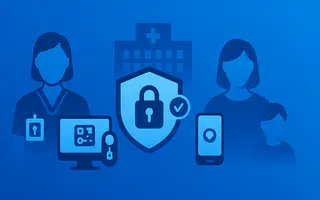
Regulatory & risk context for healthcare IAM
Healthcare IAM lives at the intersection of life-critical clinical workflows and some of the most stringent data protection requirements in the world. In this environment, every login is a safety decision as much as it is a security control. The regulatory baseline in the United States is the HIPAA Security Rule, which defines technical safeguards for access control, audit, integrity, and transmission security for electronic protected health information (ePHI). Those safeguards are intentionally technology-agnostic, so organizations can implement what’s “reasonable and appropriate” for their size, risk, and systems, but they also set clear expectations around unique user identification, emergency access procedures, automatic logoff, encryption, and audit controls. Aligning healthcare IAM to this baseline means designing authentication and session management that protects ePHI by default while allowing fast, reliable access for clinicians and patients.
What has changed over the last few years is the threat model and enforcement climate. Federal guidance and industry frameworks now emphasize phishing-resistant authentication, remote access protections, and auditable emergency workflows. The HHS 405(d)/HICP program distills sector-specific practices for healthcare providers and technology partners; in parallel, NIST’s Digital Identity Guidelines (SP 800-63, Revision 4) modernize expectations for authenticator assurance. Together they push healthcare IAM beyond “strong passwords plus OTP” toward cryptographic, origin-bound authentication that resists modern phishing kits and session replay, and they reinforce the need for contextual, Zero Trust-style checks at and after login.
HIPAA Security Rule technical safeguards (access control, audit)
HIPAA’s technical safeguards require covered entities and business associates to implement access controls that allow system access only to authorized users and software, to establish emergency access procedures, and to enforce automatic logoff and mechanisms to encrypt and decrypt ePHI. They also mandate audit controls, hardware, software, and/or procedural mechanisms to record and examine activity in systems handling ePHI. For IAM leaders, this translates into unique accounts for all users (including shared-device workflows), reliable session termination on inactivity, and encryption-backed channels and storage. It also means audit trails for authentications, privilege elevations, break-glass events, and key clinical actions must be retained and reviewable.
HHS provides additional interpretive guidance to help organizations implement these requirements and to prepare for OCR audits. The guidance reinforces that flexibility of approach applies, but documentation and demonstrable controls are essential: organizations must show how access decisions are made, logged, and reviewed, and how emergency access, revocation, and session security work in practice. For healthcare IAM programs, building auditability into the authentication fabric, rather than relying solely on downstream application logs, reduces blind spots and accelerates investigations.
NIST SP 800-63B authenticator assurance levels (AALs) in healthcare use cases
NIST’s Digital Identity Guidelines, updated in Revision 4 (July 2025), reframe authenticator assurance levels (AALs) around modern threats and usability realities. At AAL1, single-factor authentication is permitted; at AAL2, proof of possession and control of two distinct factors is required and a phishing-resistant option must be offered; and at AAL3, authentication is based on public-key cryptography, requires two factors, and mandates a phishing-resistant authenticator with a non-exportable key. Crucially, the guidance formalizes step-up: sessions can be elevated to a higher AAL when a specific action (e.g., signing a high-risk order) warrants it. For healthcare IAM, that means mapping routine access to AAL2 with a phishing-resistant path and elevating to AAL3 for the most sensitive actions, such as medication overrides or privileged EHR administrative functions.
The update also clarifies how passkeys and other FIDO authenticators align to these levels: synced passkeys can meet AAL2 when properly implemented, while device-bound passkeys or hardware security keys can satisfy AAL3 requirements. This enables practical pathways to roll out passwordless authentication across the workforce without sacrificing assurance, and it creates a standards-based roadmap to retire legacy OTP channels in favor of phishing-resistant methods.
HHS 405(d)/HICP: MFA and remote access practices
HHS’s 405(d) Health Industry Cybersecurity Practices (HICP) translate national cybersecurity priorities into healthcare-specific steps. HICP repeatedly recommends MFA for remote access, including VPN/RDP entry points and remote administration of medical devices, to mitigate stolen-credential attacks. For IAM teams, this means baking phishing-resistant MFA into clinician VPNs, third-party support channels, and cloud admin sessions, and ensuring that any remote desktop solution is shielded by MFA and monitored. These practices align with Zero Trust patterns, verify explicitly, use least privilege, and continuously monitor, and they are particularly important where workforce devices are shared or mobile.
As enforcement and policy evolve, regulators are also signaling stronger expectations around mandatory MFA and periodic compliance audits. While proposed rule changes are not yet final, the trendline is clear: healthcare organizations are expected to demonstrate MFA coverage and auditable IAM controls across their estates, not just in select apps. Design now for phishing-resistant MFA everywhere, and you’ll be better positioned for what’s coming.
Designing clinician-friendly authentication
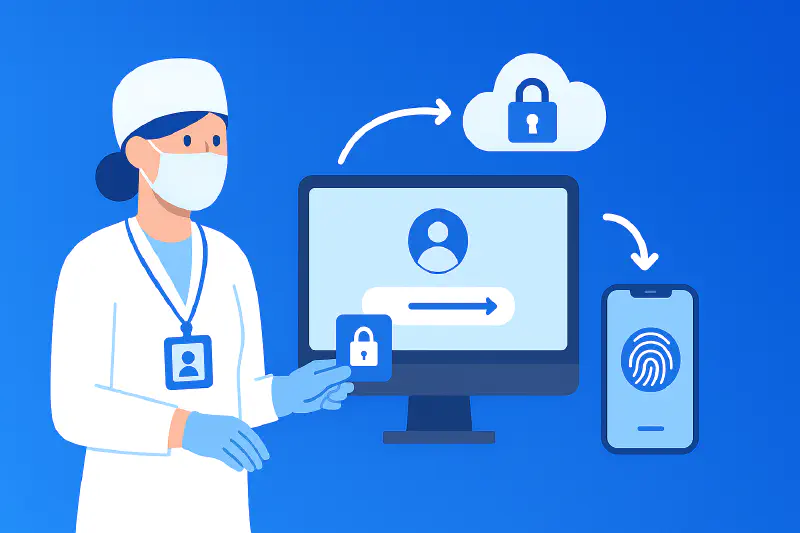
Authentication in healthcare must be fast where it can be and stronger where it must be. The design challenge is to meet AAL2/AAL3 assurance with minimal friction, particularly in high-tempo clinical settings where seconds matter. That starts with removing passwords, which clinicians forget, lock, and reset at the worst possible moments, and replacing them with cryptographic sign-in that binds the user, the device, and the origin. Modern passwordless IAM reduces helpdesk overhead and raises security and speed simultaneously.
EHR login speed vs security: tap-and-go, biometrics, WWPass
Shared badge-tap or “tap-and-go” flows, when implemented with strong backing authentication, can dramatically shorten EHR access time without lowering assurance. Hospitals have reported substantial workflow improvements when clinicians can tap a badge to resume a roaming session on an Epic workstation rather than re-typing credentials. Biometrics on mobile devices or laptops, when they unlock a passkey or cryptographic credential, offer similar speed while keeping secrets on-device. To bring these ideas into your stack with phishing-resistant cryptography, adopt a passwordless SSO pattern that replaces shared secrets with origin-bound authenticators, such as passwordless SSO that pairs cryptographic login with fast, clinician-friendly user flows.
Shared workstations, roaming sessions, and fast user switching
Clinical environments rely on workstations on wheels, nursing stations, and imaging consoles used by multiple clinicians back-to-back. IAM must support fast user switching and roaming sessions so that locking and unlocking follows the clinician, not the device. That means short inactivity timeouts with automatic logoff to satisfy HIPAA, quick re-authentication using a tap or biometric, and policies that rebind the session context to the new user immediately. Layering phishing-resistant MFA behind the tap ensures that convenience does not become a trojan horse for credential sharing or tailgating.
Step-up MFA for higher-risk orders and approvals
A single authentication at the start of a shift should not authorize every action for hours. For high-risk actions, medication overrides, controlled substance prescribing, device reconfiguration, require step-up to a higher AAL during the session, using a second bound factor or an AAL3 authenticator. Modern NIST guidance explicitly contemplates elevating a session’s assurance for such events. This balances speed for routine charting with stronger proof for safety-critical actions, and it puts IAM in line with clinical risk.
Passwordless for the healthcare workforce
Passwordless IAM for clinicians, back-office staff, and vendors reduces phishing risk and accelerates care. A practical pattern pairs federated SSO with phishing-resistant authenticators, so users sign in once with a passkey or hardware key and carry that assurance level across EHR, PACS, e-prescribing, and collaboration apps. In regulated environments, passwordless does not mean “less assurance”, it means cryptographic assurance that’s stronger than passwords and OTPs, with better auditability.
To see how passwordless maps to typical provider use cases and policy constraints, explore healthcare-specific passwordless options like WWPass for Healthcare, which focus on clinician and patient access, high-assurance cryptography, and seamless roaming across devices and sessions.
Device-bound/passkey options and smart cards
Healthcare IAM should support a portfolio of phishing-resistant authenticators to meet different workflows and budgets. Device-bound passkeys (stored in platform secure enclaves) or FIDO2 security keys meet AAL3 in NIST’s model, while synced passkeys can meet AAL2 when implemented per guidance. Smart cards remain viable where a PIV-style footprint already exists, but modern passkeys reduce card lifecycle overhead for many providers. The key is to bind authenticators to the user and device in a way that prevents credential export, enforces user verification (biometric or PIN), and resists phishing at the protocol level.
SSO + context/risk signals (location, device health)
Passwordless SSO minimizes credential sprawl, but the security jump happens when it’s combined with contextual access policies, device health attestation, geolocation consistency, network path, and behavioral signals, drawn from Zero Trust architecture principles. In practice, that means treating each session as untrusted until both identity and device are verified, and re-evaluating trust over time. Providers can implement this with a central identity provider enforcing modern policies, integrated EDR posture checks, and fine-grained, per-action authorization. For an SSO approach that natively avoids usernames and passwords, consider WWPass SSO, which fuses passwordless authentication with centralized access policies.
Break-glass access and audited emergency overrides
HIPAA requires an emergency access procedure so clinicians can obtain necessary ePHI during emergencies. In IAM terms, break-glass should be rare, time-boxed, and fully audited, with immediate notifications and post-event review. EHRs often support break-glass workflows that prompt for a reason and stamp the chart accordingly; your IAM fabric should supplement that with independent logs at the authenticator and identity provider layers. Build the runbook, test it, and make sure every break-glass event is visible to compliance and clinical leadership.
Patient portal login & identity
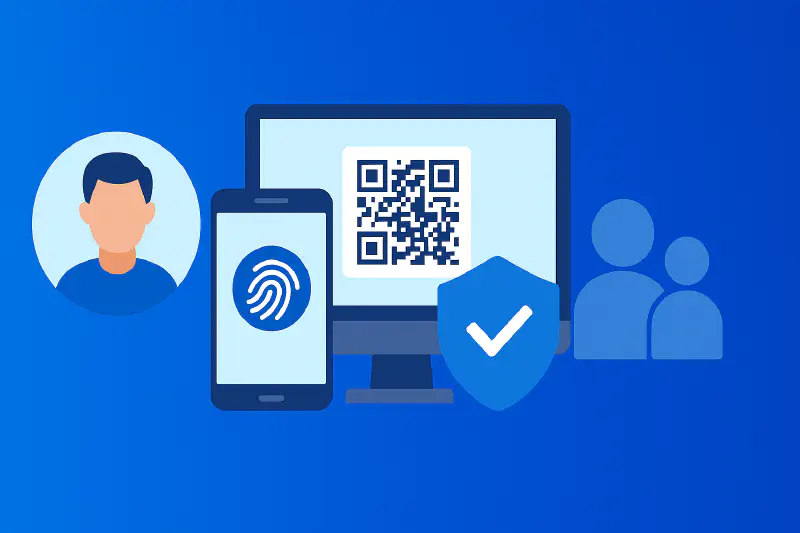
Patient-facing IAM must strike a delicate balance: high security without excluding vulnerable populations. The starting point is NIST’s division between identity proofing (SP 800-63A) and authentication (SP 800-63B). You first decide how confidently you must bind a portal account to a person (Identity Assurance Level, IAL), then choose an authenticator experience (AAL) that matches the risk of the data and actions exposed, billing, records access, proxy management, messaging, and appointment scheduling.
Remote identity proofing options for patients & proxies
NIST’s identity proofing guidance recognizes a spectrum from IAL1 (“some” confidence) to IAL2 (“high” confidence) and IAL3 (“very high” confidence, typically with in-person biometrics). Many patient portals can operate at IAL1 when only low-risk services are available, but record access and proxy authority often justify IAL2 with remote document verification or authoritative records checks. Proxies, parents, caregivers, legal guardians, require additional proofing and ongoing attestations to ensure the proxy relationship is current and appropriate, especially for pediatric and behavioral health contexts. Clear renewal and revocation processes are essential to prevent inappropriate access.
MFA choices for patients (balancing security and accessibility)
For patients, pick friction-right authenticators with a path to phishing resistance. Passkeys deliver “tap to sign in” convenience on phones and desktops and resist the phishing kits that harvest passwords and OTPs. Where passkeys aren’t yet feasible, prioritize app-based push with number matching or TOTP over SMS, and plan an upgrade path to passkeys as device support grows. Align the authenticator portfolio to NIST’s AAL2 baseline for most portals, offering a phishing-resistant option and making it the default for higher-risk actions like downloading complete records or approving sensitive data sharing. Provide inclusive alternatives for users with accessibility needs and for those without smartphones, hardware security keys at clinics, or assisted enrollment during visits.
Recovery flows that don’t re-introduce phishable factors
Account recovery is where many portals unintentionally weaken assurance by falling back to email links or SMS OTPs alone. NIST’s updated guidance treats recovery as a distinct, less convenient but more controlled process, with options such as saved recovery codes, issued recovery codes sent to verified addresses, trusted recovery contacts, and re-proofing that mirrors the original identity proofing strength. For AAL2 accounts, recovery requires two codes from different channels, one code plus a bound authenticator, or repeat proofing. For AAL3, biometric comparison tied to the original IAL3 enrollment may be required. The principle is simple: recovery should be at least as hard to subvert as login. If you want a concrete example of recovery that avoids phishable secrets while staying user-friendly, review the revocation and device replacement flow in the WWPass Key App recovery experience and adapt similar guardrails for your portal.
Putting it all together for healthcare IAM
A modern healthcare IAM program weaves the above requirements and practices into a coherent, passwordless-first architecture. For the workforce, roll out phishing-resistant passkeys as the default, provide device-bound options for AAL3 roles, and integrate with federated SSO so sign-in happens once and carries across clinical systems. Add contextual checks, device health, network path, behavioral baselines, so session risk can trigger step-up for high-risk workflow moments. For patient portals, ensure remote identity proofing is proportionate to the data and authority granted, offer passkeys and accessible alternatives, and design recovery that resists phishing as strongly as login.
If you want to explore a concrete passwordless stack that aligns with these principles and is approachable for both clinicians and patients, consider the patterns described in passwordless SSO, the healthcare-specific guidance in WWPass for Healthcare, and the operational advantages of centralized WWPass SSO. These approaches combine cryptography, usability, and auditability so that security helps care happen faster, not slower.
Privacy, consent, and equity
In healthcare IAM, privacy is not merely a legal requirement, it is the basis for trust between patients, caregivers, and clinicians. The HIPAA Privacy and Security Rules define how protected health information must be used, disclosed, and safeguarded; they expect covered entities and business associates to implement controls that ensure only authorized individuals can access ePHI and that every access is appropriately recorded. The language of the rules is intentionally technology-agnostic, but the direction is clear: unique identification of users, auditable decision trails, integrity protections, and secure transmission are the bedrock upon which all identity decisions rest. When an IAM program is built around these pillars while minimizing friction in day-to-day workflows, privacy becomes a lived experience rather than a checkbox.
Consent complicates the picture in productive ways. The HIPAA Privacy Rule recognizes personal representatives and establishes rights of access and amendment, but also allows providers to exercise professional judgment when disclosures might endanger the patient. For minors, HIPAA generally treats parents or legal guardians as personal representatives, with notable exceptions when state law allows a minor to consent to their own care or when the parent agrees to a confidential arrangement between provider and youth. These nuances have immediate IAM implications: portals must support proxy relationships that can change over time; systems must encode the “minimum necessary” principle; and access reviews must be able to revoke or attenuate proxy rights as circumstances change. Healthcare IAM policies should explicitly map role-based access and consent states to technical entitlements and session behavior to keep the law, clinical intent, and system behavior aligned.
Equity extends privacy and consent from the “what” to the “who.” Under Section 1557’s nondiscrimination framework, providers must ensure equal access to services regardless of race, color, national origin, sex, age, or disability, and that includes digital front doors such as telehealth and patient portals. Language access obligations require that important documents are translated and that qualified interpreters and auxiliary aids are available at no cost, while accessibility standards require that websites and apps can be used by people with disabilities. A modern healthcare IAM strategy weaves these obligations into design: enrollment flows must anticipate limited English proficiency, authentication must be usable without memory-based puzzles, and recovery must not require channels a patient cannot easily access. This is where passwordless, phishing-resistant methods shine: by removing cognitive load and hostile captchas, they make secure access more inclusive.
Accessibility (508/WCAG) and language support
For public-facing properties, including portals used by Medicare and Medicaid beneficiaries, Section 508 serves as the federal benchmark for ICT accessibility and incorporates the WCAG criteria as the testable standard. Although the 508 “refresh” references WCAG 2.0 A/AA, the practical target today is WCAG 2.2, which adds success criteria tailored to real authentication tasks. The “Accessible Authentication” criteria formalize what many patient advocates have said for years: don’t force people to remember or transcribe secrets just to see their own data. Authentication must offer a secure path that does not require cognitive function tests; passkeys and app-based cryptographic confirmation meet that bar while resisting phishing and replay. When portal design aligns to WCAG 2.2 and to 508’s procurement and conformance expectations, accessibility and security reinforce each other rather than trade off.
Language access is equally operational. IAM leaders should treat preferred language as a first-class identity attribute, captured during enrollment, respected in every notification, and used to drive interpreter options for high-risk actions. Section 1557’s final rule makes clear that important documents and digital experiences must be understandable to LEP patients and that interpreters and aids be provided free of charge. In practice, that means templated consent prompts and step-up authentication explanations in common languages, with escalation paths to human assistance for recovery, proxy management, and sensitive data requests.
Proxy/guardian access, minors, and consent models
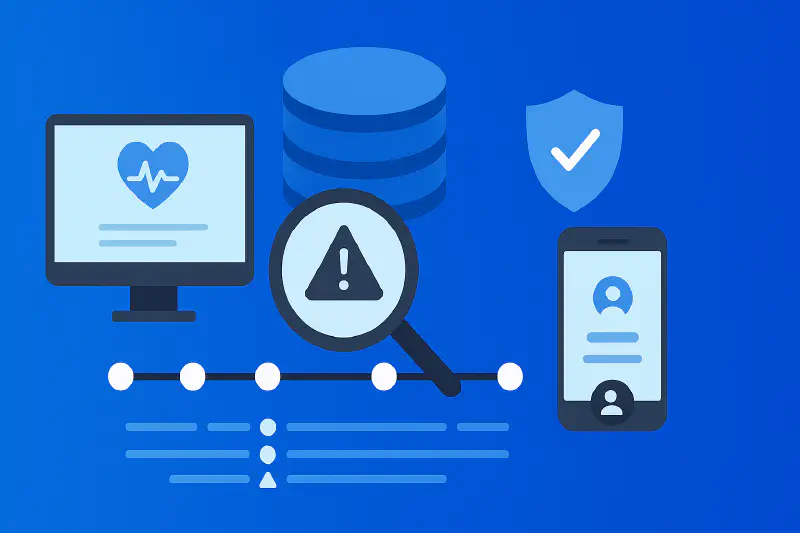
Patient portals increasingly support rich proxy models: parents managing pediatric care, adult children assisting elders, caregivers collaborating with clinicians, and temporary surrogates acting under a medical power of attorney. The HIPAA Privacy Rule requires covered entities to treat a qualified personal representative as the individual for purposes of access rights, but implementations must also honor exceptions when minors can consent independently, when confidentiality agreements exist, or when disclosure would endanger the patient. IAM designs should encode proxy relationships as verifiable claims with expiration and review dates, tied to documentation captured during enrollment or clinical intake. They should also support graduation, for example, converting a pediatric account to an adult account with appropriate records segregation when the patient reaches the age of majority, and granularity, such as read-only access to billing versus full clinical access. Auditable requests and attestations are critical: every proxy creation, renewal, and revocation should be traceable to a reason, approver, and time.
Where state law intersects with HIPAA, IAM must be flexible. A parent might be a personal representative in one scenario but not in another if the minor consented to services independently under state law. Clinicians retain professional discretion to limit disclosures if it is in the best interest of the patient; portals and call-center workflows must respect those decisions. Designing robust, documented exception handling, with clear appeal and review paths, prevents ad-hoc workarounds that erode both privacy and safety.
Implementation blueprint
A credible blueprint for healthcare IAM starts with risk and ends with lived usability. Begin by mapping your regulatory and organizational obligations to concrete assurance requirements: what AAL is required for routine EHR work, what must be stepped up for controlled substances, and what IAL/AAL combinations fit your portal features. Use NIST SP 800-63 as your common language: AAL2 for most clinician and patient use cases with a phishing-resistant option, and AAL3 for the rare cases where “very high” assurance is warranted, such as privileged EHR administration or certain high-risk orders. From there, pick an architecture that minimizes shared secrets. A federated IdP/SSO front-ends your clinical and business apps; authentication is handled by a passwordless method like passkeys or a cryptographic key app; and risk signals from device health, network path, and location guide access decisions in line with Zero Trust.
This blueprint is not theoretical. Passwordless SSO platforms that avoid usernames altogether and bind authentication to a device or cryptographic token deliver both speed and assurance; for a concrete pattern that aligns with these principles while integrating with your existing IdP and federation protocols, see WWPass SSO and the implementation-focused overview in Passwordless SSO for Web & Mobile Apps. These resources illustrate how to retire passwords without breaking legacy apps and how to keep sessions phishing-resistant even on shared workstations.
Governance: IAM council, clinical champions, change management
Governance makes or breaks adoption. Establish an IAM council that includes security, compliance, EHR and clinical informatics leadership, health equity representatives, and frontline clinicians. Give the council a clear remit: define assurance mappings, approve authenticator portfolios, adjudicate exceptions, and own reporting to compliance and the board. Clinical champions should co-design workflows such as tap-and-go access, roaming sessions, and fast user switching, and should co-own UX guardrails like plain-language prompts and transparent consent messaging. Change management must keep pace with clinical reality: migrate units in waves, pair every rollout with on-unit coaching, rehearse break-glass scenarios, and staff a white-glove desk for the first weeks so no clinician is left stranded at login during patient care. Tie incentives to outcomes that matter to the floor, time-to-chart, order latency, and reduction of lockouts, so the project is felt as help, not hassle.
Technology stack: IdP/SSO, WWPass, MDM, EHR integration
Technically, the stack centers on a federating IdP/SSO that supports SAML and OIDC and enforces contextual policy. Your authenticator tier should prioritize phishing-resistant choices: device-bound passkeys, hardware security keys for AAL3 personas, and a cryptographic mobile key app for cross-device login. With shared workstations, keep secrets off the workstation entirely by pairing the IdP with QR-mediated or proximity-based approval flows. Modern passwordless offerings make this straightforward; for example, WWPass for Healthcare explains how to secure clinician and patient identities across EHR, PACS, and portals, and WWPass SSO shows how to avoid usernames and passwords altogether while benefiting from centralized policy. Mobile device management anchors device trust by enforcing OS versions, screen locks, and disk encryption; conditional access checks device posture at login and throughout the session in line with NIST 800-207 Zero Trust. EHR integration relies on your vendor’s SSO capabilities, Epic, Cerner, MEDITECH, and others all support SAML/OIDC entry, plus step-up hooks for specific actions, such as controlled substance e-prescribing.
For patient-facing access, keep recovery and re-enrollment front and center. Passwordless IAM is only as resilient as its recovery: plan for device loss and upgrade with an approach that does not fall back to phishable channels. A practical model, documented in WWPass Key App recovery, pairs device change with out-of-band cryptographic verification and automatic invalidation of the prior device, minimizing social-engineering risk without stranding users.
Policy artifacts: AAL mappings, recovery, exception handling
Formal artifacts keep the program auditable and durable. The AAL mapping document ties workforce roles and portal features to assurance requirements following NIST SP 800-63B-4: routine charting at AAL2 with a phishing-resistant option; privileged admin actions and certain high-risk orders at AAL3; patient portal actions at AAL2 with step-up when exporting full records or changing proxy relationships. The recovery policy codifies how a user regains access after device loss: acceptable proofs, channels, timeouts, rate limits, and staff roles; it emphasizes methods that are at least as hard to subvert as login itself. The exception policy details when and how clinicians may invoke break-glass or when IT may grant temporary bypass, always with explicit reasons, tight expiry, and automatic notifications to compliance and the patient where appropriate. Taken together, these artifacts turn a strong authenticator portfolio into a governed access system, rather than a collection of tools.
Audit readiness & documentation
Audit readiness starts with the premise that if it isn’t logged, it didn’t happen. At minimum, you need immutable logs for authentication, authorization changes, privilege elevation and step-up, break-glass, EHR access events, and portal transactions. Your IdP/SSO, EHR, and critical apps should generate tamper-evident logs that can be correlated by user, device, session, and request identifiers and retained per your records policy. Many EHRs are certified against ONC criteria that include auditable events, tamper resistance, and audit reporting, which you should leverage during investigations and for compliance reporting. IAM teams should own a living “evidence binder” that maps every HIPAA safeguard and ONC audit requirement to specific controls, screenshots or exports, and operational runbooks. That binder should include your risk analysis, AAL/IAL mappings, exception logs and post-mortems, and the latest change management artifacts for authenticator rollouts and recovery process updates.
Evidence for HIPAA §164.312: unique IDs, log trails, transmission security
HIPAA’s technical safeguards at 45 CFR §164.312 provide a useful checklist for both workforce and portal access. Access control requires unique user identification, emergency access procedures, automatic logoff, and mechanisms for encryption/decryption. Audit controls mandate that you record and examine activity in systems containing ePHI. Integrity and person or entity authentication require that data not be improperly altered or destroyed and that you verify the identity of those seeking access. Transmission security requires protections, typically encryption, to guard against unauthorized access over networks. Your evidence should therefore include IdP configuration showing unique IDs and automatic session timeouts; runbooks for break-glass invocation and review; screen captures or exports proving at-rest and in-transit encryption; and cross-system audit trails that tie a user’s identity to their EHR and portal actions.
Logging EHR access and patient portal events for investigations
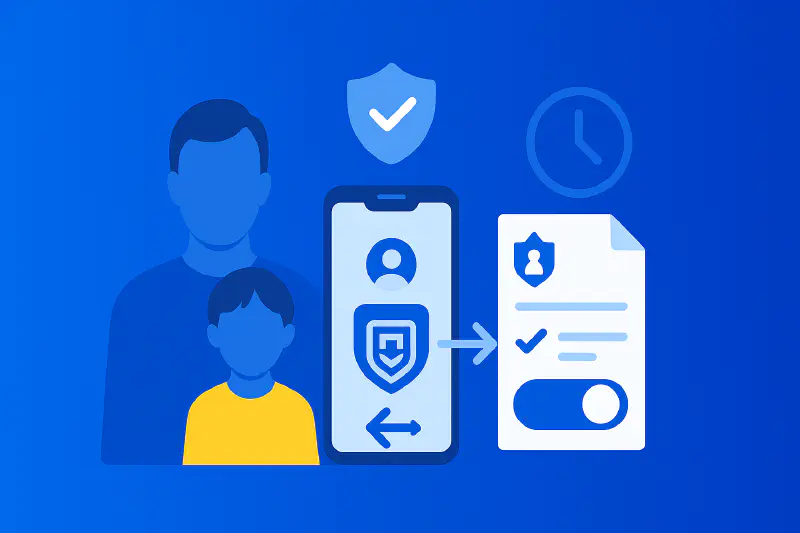
When an investigation begins, whether due to a patient complaint, an odd access pattern, or a breach notification letter, time to truth depends on your logging quality. Certified EHRs and ancillary systems subject to ONC’s criteria must record who did what, when, and often from where, and they must protect those logs against tampering while enabling exportable audit reports. Your IdP/SSO should fill the gaps by logging authentications, risk decisions, step-up prompts, device posture, IP and ASN, and session IDs that downstream apps echo into their records. Patient portals deserve the same rigor: log enrollment and proofing steps, authenticator registration or removal, recovery attempts, proxy changes, high-risk downloads, and messaging related to sensitive topics. The goal is that a compliance analyst can reconstruct an end-to-end timeline across IdP, EHR, and portal with a common session key and produce an audit report that stands up to OCR scrutiny.
FAQs
Is MFA mandatory for clinicians under HIPAA?
Historically, HIPAA did not explicitly mandate MFA; rather, it required “reasonable and appropriate” safeguards based on risk. However, in January 2025 HHS proposed significant Security Rule updates that would require MFA and encryption with limited exceptions. These requirements are not final until HHS publishes a final rule, but the direction of travel is unmistakable. Separately, some clinical actions already mandate strong authentication under other laws: for example, the DEA’s EPCS rules require two-factor authentication to sign electronic prescriptions for controlled substances. Many sector frameworks, including HHS’s own 405(d)/(HICP), also recommend MFA for remote access and privileged activities. In practice, the safest answer today is: implement phishing-resistant MFA across the workforce now to meet emerging obligations and reduce breach risk, and prepare to demonstrate coverage during audits.
What AAL should we target for patient portals?
For most patient portals, AAL2 is the right baseline because it requires two-factor authentication and, under the latest NIST guidance, that an AAL2 service offer a phishing-resistant option. Pair AAL2 with proportionate identity proofing for the features you expose and offer step-up for especially sensitive actions, such as downloading an entire clinical record or changing a proxy/guardian arrangement. When threat and harm potential justify it, for example, clinician-facing admin panels that are occasionally exposed to patients through mixed roles, architect for AAL3 with device-bound passkeys or security keys. The important thing is to document your rationale and keep it consistent with NIST SP 800-63B-4 so you can evidence it in audits.